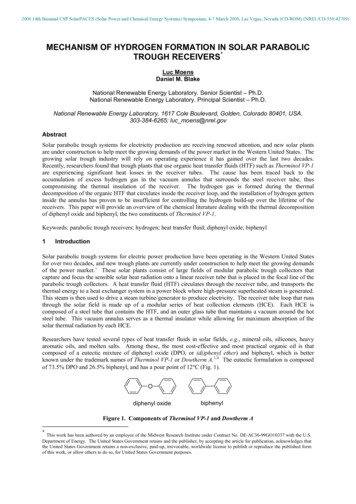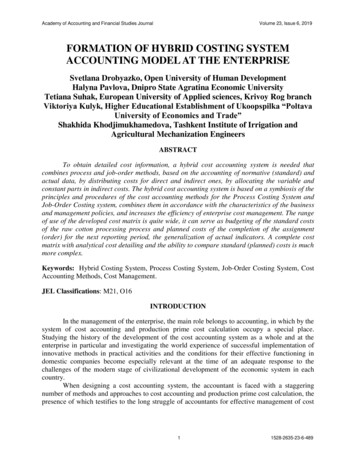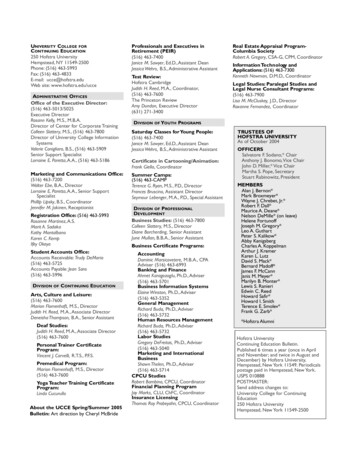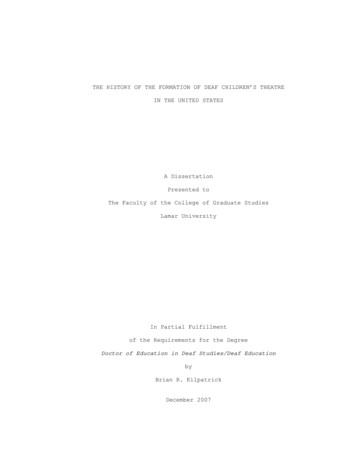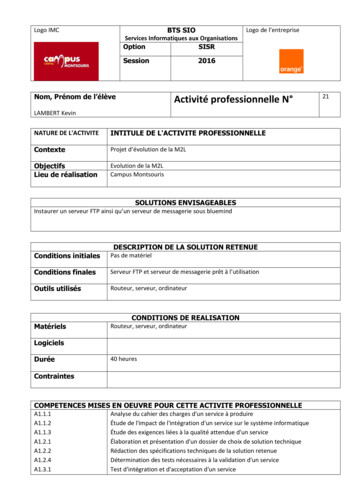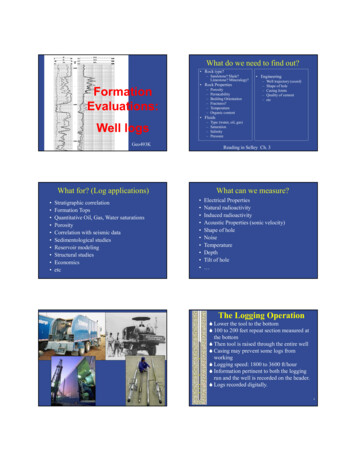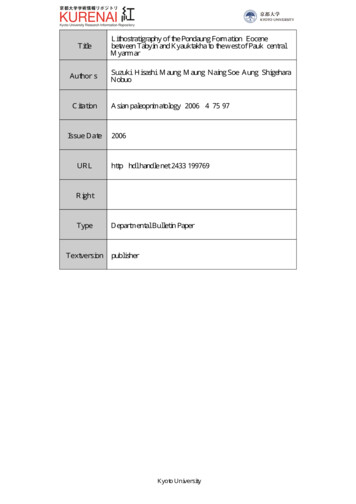
Transcription
TitleAuthor(s)CitationIssue DateURLLithostratigraphy of the Pondaung Formation (Eocene)between Tabyin and Kyauktakha to the west of Pauk, centralMyanmarSuzuki, Hisashi; Maung, Maung; Naing Soe, Aung; Shigehara,NobuoAsian paleoprimatology (2006), 4: eTextversionDepartmental Bulletin PaperpublisherKyoto University
Asian Paleoprimatology, vol. 4:75-97 (2006)Kyoto University Primate Research InstituteLithostratigraphyof the PondaungTabyin and KyauktakhaFormation (Eocene) betweento the west of Pauk, central ty, ersiteitLeoben, Departmentfir gy, chInstitute, yin-Kyauktakharoutearemeasuredanddescribedin detail.ThePondaungFormationofthesectionis Thetotalthicknessof amountsto ca. ntainsa erMemberof theformationconsistsmerelyof sandstonethat stto thefossil-bearingUpperMemberof thePondaungFormationin ncesoftheUpperMemberof desWegszwischenTabyinundKyauktakhawurdenvonder komplettenAbfolgederPondaung-Formationdie Saulenprofileerstelltunddetailliertbeschrieben.Die Pondaung-Formationbestehthier aus Sand-,Silt- und Tonsteinmit geringenAnteilenan kha-Profilsbetragtca. 1.170m. enAnteilan schlieBlichaus Sandstein,in nGliedderPondaung-Formationin chenSedimentationsbe75
Suzuki et al.dingungen abgelagert, im Rahmen derer es zur Uberlieferung von Wirbeltierknochen kaumkommen konnte.IntroductionThe Eocene Pondaung Formation is widely distributed in central Myanmar, and its geology has been studied in some areas. In the areas of Pale and Myaing townships, the PondaungFormation consists mainly of fluviatile deposits and yields the well-preservedterrestrial ver-tebrate fossils (e.g., Aye Ko Aung, 1999, 2004; Aung Naing Soe, 1999; Aung Naing Soe etal., 2002). On the other hand, the Pondaung Formation in the Minbu district exhibits shallowmarine environments(Shwezettawarea; Aung Khin and Kyaw Win, 1969; Maung Maung,1994). The area studied in this paper is located along a roadside of Tabyin to Kyauktakha tothe west of Pauk township(Figure 1). Geographically,this area is located about 70-80 kmsouthwest of the areas of Pale and Myaing townships and about 130-140 km north to northnorthwest of the Minbu area. It is expected that the study area lies in the transitionaltween the fluviatile and shallow marine environments.area be-In addition, the strata of the PondaungFormation of the study area dips to the east monotonously,so that the whole sequences fromthe base to top of the formation crop out in a relatively narrow area.Here we describe a lithologic column of the whole sequences of the Pondaung Formation along the route of Tabyin to Kyauktakha villages to clarify the total thickness and lithostratigraphy of the Pondaung Formation in this area.GeologicThe study area is geotectonicallysettinglocated in the western part of the Inner-BurmanTerti-ary Basin (Figure 1), in which the Cenozoic fluviatile to shallow marine sediments are mainlydeposited(Chhibber,basins are recognised,1934; Bender, 1983). In the Inner-BurmanTertiary Basin some sub-one of which is called the north to south stretching Minbu Basin dis-tributed between the latitudes 20 N and 22 N. The geologic structure of the Minbu Basin ischaracterisedby the Salin Syncline (Bender, 1983), and the study section is situated on itswestern limb.Along the road between Kyauktu and Pauk (Figure 1) the Eocene to Quaternary formations are distributed.These formationsstrike approximatelynorth to south and dip about40-60 eastwards. The following formations and group are distributed between Kyauktu andPauk in ascending order: the Eocene Laungshe Formation, the Eocene Tilin Formation, theEocene Tabyin Formation, the Eocene Pondaung Formation, the Eocene Yaw Formation, theOligocene Shwezetaw Formation, the Oligocene Padaung Formation, the Oligocene Okhmintaung Formation,the Miocene Kyaukkok Formationand the Miocene to lower QuaternaryIrrawaddy Group (Cotter and Clegg, 1938; IGCP National Committee,1981). Among the for-mations, the here described section focuses on the Pondaung Formation that is conformablyunderlain by the Tabyin Formation and is conformably76overlain by the Yaw Formation. The
\Lithostratigraphyof the PondaungAFormationto the westof PaukB\ to Thn111(r-tca94-30Tth EtosATabyrIpA.Ct %.„,It.'5-).i)3kiii' Yang?,02[K11.BangkokO4).LP.,,.map of ions.Myanmar.(1)B,RoadLocationsection. (2) Sectionsouthof the road.geologic age of the Pondaung Formation are discussed by Aye Ko Aung (1999, 2004) andTsubamoto et al. (2000, 2002, 2006 in this volume) in detail based on the studies in the areasof Pale and Myaing townships, and a Middle Eocene age has been estimated.ColumnarsectionsbetweenTabyinThe geologic columns of the whole sequencesTabyin-Kyauktakhaand Kyauktakhaof the PondaungvillagesFormationalong theroute are shown in Figures 2 to 18. Two sections were measured, the roadsection and the section south of the road (Figure 1). These two sections are connected at thehorizon 670.9 m with the characteristiclithology of the large-scale trough cross stratificationwith pebbles (Figures 19 and 20). The total thickness of the Pondaung Formationmeasured section amounts to 1,167.5 m. Lithostratigraphiccharacteristicsalong theare summarised asfollows.(1) The Pondaung Formation along the Tabyin-Kyauktakha route is lithologically subdivided into the Lower and Upper Members at the horizon 724.8 m. The thickness of the LowerMember amounts to 724.8 m and that of the Upper Member amounts to 442.7 m. These twomembers cannot be directly correlated with those of the areas of Pale and Myaing townships(Aye Ko Aung, 1999) because of the lithologic differences.(2) The Lower Member of the formation is composed mainly of sandstone, siltstone,and claystone sequences. The minor amounts of coal, acidic tuff and gritty-pebbly sandstoneare also included in the Lower Member. Two thin acidic tuff layers are intercalatedwithin the claystone sequences that are accompaniedonlyby coal and/or peat beds. These acidictuff layers will be the clues to correlate with the PondaungFormation in the fossil-bearingPaukkaung area (see Tsubamoto et al., 2002; Maung Maung et al., 2005; Suzuki et al., 200677
Suzuki et al.in this volume).(3) Sandstone beds with the large-scale trough cross bedding and pebbles are appearedat the higher horizon of the Lower Member (around horizon 670 m; Figures 19 and 20).(4) The Upper Member of the formation consists mainly of thick sandstone sequencesthat exhibit the sedimentary structures under high energy conditions (e.g., trough-type crossstratification).(5) Although the Upper Member of the Pondaung Formation in the areas of Pale andMyaing townships yields well-preserved fossil vertebrates, the Upper Member of the formation along the Tabyin-Kyauktakharoute yields little vertebrate fossil bones. This is due to thedifferences in lithology and sedimentaryenvironment. While the Upper Member of the areasof Pale and Myaing townships includes thick claystone sequences that yield rich fossil vertebrates (see Suzuki et al., 2006 in this volume), the Upper Member of the Tabyin-Kyauktakharoute is composedmainly of thick sandstone strata that were deposited under high energycurrents suggestedby the trough-typecross stratification.The sandstonesdeposited underhigh energy currents could not make fossil preservation possible.AcknowledgementsThis report is based on the results of the field survey in February 2005. We would liketo express our sincere thanks to U Min Swe (Departmentof Archaeology,Bagan Branch),U Win Kyaing (Department of Archaeology, Pyey Branch) and U Zin Maung Maung Thein(Primate Research Institute, Kyoto University) for organising and supporting our field survey. Special thanks are due to Prof. Dr. Masanaru Takai (Primate Research Institute, KyotoUniversity) and Dr. Naoko Egi (Primate Research Institute, Kyoto University) for helping ourfield measurementsof lithologic columns and for reviewing the manuscript. We are also verygrateful to the personnel of the Myanmar-Japan (Kyoto University) Joint Fossil ExpeditionTeam, to the personnel of Ministry of Culture of Myanmar, to Director General U Nyunt Han(Department of Archaeology, Ministry of Culture of Myanmar), and to the personnel of Embassy of Japan in Yangon (Myanmar) for their guidance and help for our surveys. We wouldbe grateful to Dr. Matthias Auer (MontanuniversitatLeoben) for his correction of our Germansummary. The financial supports were provided by the MEXT Overseas Scientific ResearchFund (09041161, 14405019, 16405018) and by the MEXT Grant-in-Aid for the 21st CenturyCOE Program (A14 to Kyoto University).ReferencesAung Khin and Kyaw Win (1969) Geology and hydrocarbon prospects of the Burma Tertiary Geosyncline.Union of Burma Journal of Science and Technology2:52-73.Aung Naing Soe (1999) Sedimentary facies of the upper part of the Pondaung Formation (in centralMyanmar) bearing late Middle Eocene anthropoid primates. p.152-178. In "Proceedings of thePondaung Fossil Expedition Team." Pondaung Fossil Expedition Team (ed.) Office of StrategicStudies, Ministry of Defence: Yangon.78
Lithostratigraphy of the Pondaung Formation to the west of PaukAung Naing Soe, Myitta, Soe Thura Tun, Aye Ko Aung, Tin Thein, Marandat, B., Ducrocq, S., and Jaeger,J.-J. (2002) Sedimentary facies of the late Middle Eocene Pondaung Formation (central Myanmar) andthe paleoenvironments of its anthropoid primates. Comptes Rendus Palevol 1:153-160.Aye Ko Aung (1999) Revision on the stratigraphy and age of the primates-bearing Pondaung Formation.p.131-151. In "Proceedings of the Pondaung Fossil Expedition Team." Pondaung Fossil ExpeditionTeam (ed.) Office of Strategic Studies, Ministry of Defence: Yangon.Aye Ko Aung (2004) The primate-bearing Pondaung Formation in the upland area, northwest of CentralMyanmar. p.205-217. In "Anthropoid origins: new visions." Ross, C. and Kay, R.F. (eds.) KluwerAcademic/Plenum Press: New York.Bender, F. (1983) Geology of Burma. Gebriider Borntraeger: Berlin. 293pp.Chhibber, H.L. (1934) The geology of Burma. Macmillan: London. xxviii 538pp.Cotter, G. de P. and Clegg, E.L.G. (1938) Geology of parts of Minbu, Myingyan, Pakokku, and lowerChindwin Districts, Burma. Memoirs of the Geological Survey of India 72:x1 1-136,pls.1-11.IGCP National Committee (1981) Stratigraphic committee field excursion in the Saw, Tilin and Gangawareas. Field excursion no.8, p.1-15, apdx A-D, pertographic descriptions and geological map.Maung Maung (1994) Petrology of the Shwezettaw—Kyauk-Oo—NgapeArea, Minbu and Ngape townships,Magway Division. M. Sc. Thesis, Mandalay University, Mandalay. 154 pp., 101 figs., 53 tabs., 1 map.Maung Maung, Thaung Htike, Tsubamoto, T., Suzuki, H., Chit Sein, Egi, N., Zaw Win, Zin MaungMaung Thein, and Aye Ko Aung (2005) Stratigraphy of the primate-bearing beds of the EocenePondaung Formation at the Paukkaung area, central Myanmar. Anthropological Science 113:11-15.Suzuki, H., Maung Maung, Zaw Win, Tsubamoto, T., Zin Maung Maung Thein, Egi, N., Takai, M., andShigehara, N. (2006) Stratigraphic positions of the Eocene vertebrate localities in the Paukkaung area(Pondaung Formation, central Myanmar). Asian Paleoprimatology 4:67-74.Tsubamoto, T., Egi, N., Takai, M., Shigehara, N., Aye Ko Aung, Tin Thein, Aung Naing Soe, and SoeThura Tun (2000) A preliminary report on the Eocene mammals of the Pondaung fauna, Myanmar.Asian Paleoprimatology 1:29-101.Tsubamoto, T., Egi, N., Takai, M., Shigehara, N., Suzuki, H., Nishimura, T., Ugai, H., Maung-Maung,Chit-Sein, Soe Thura Tun, Aung Naing Soe, Aye Ko Aung, Tin Thein, Thaung-Htike, and Zin-MaungMaung-Thein (2006) A summary of the Pondaung fossil expeditions. Asian Paleoprimatology 4:1-66.Tsubamoto, T., Takai, M., Shigehara, N., Egi, N., Soe Thura Tun, Aye Ko Aung, Maung Maung, Danhara, T.,and Suzuki, H. (2002) Fission-track zircon age of the Eocene Pondaung Formation, Myanmar. Journalof Human Evolution 42:361-369.79
Suzuki et al.horizon (m)21 -42.65LegendE D , nodule20 —calicheripple/40 —convolute laminationfining and thiningupward -Idesiccation crackwood chipmud clast15 —plane bed35Fflute markTtool markburrows ) lenticular beddingcoal chipflaser beddingwavy lamination10—pebbly sandstone30 —bedded sandstoneparallel lamination/// /I5—planar-typecross stratificationtrough-typecross stratificationtuffIclaystone25-claystonesiltstone' o 0 osiltstonevery fine-grainedsandstoneF inedF T 0coa
basins are recognised, one of which is called the north to south stretching Minbu Basin dis-tributed between the latitudes 20 N and 22 N. The geologic structure of the Minbu Basin is characterised by the Salin Syncline (Bender, 1983), and the study section is situated on its western limb. Along the road between Kyauktu and Pauk (Figure 1) the Eocene to Quaternary forma-tions are distributed .
